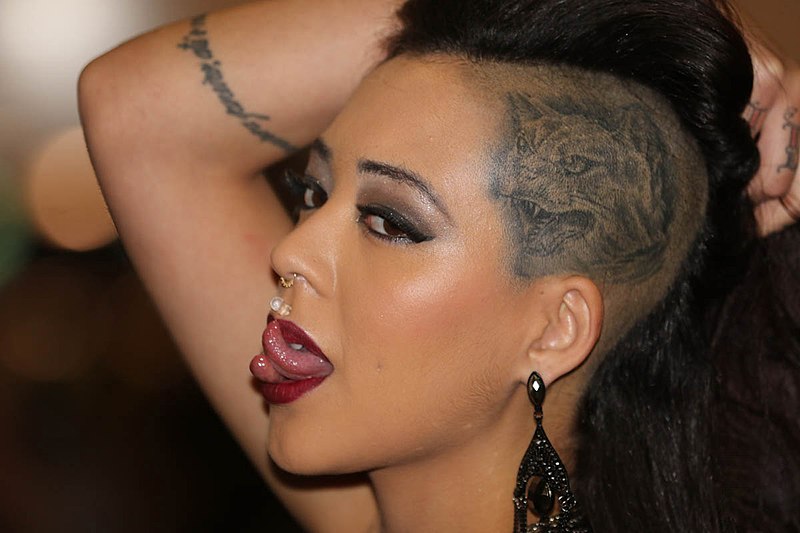ioerror JBAAAAAAAAAAAAAAM, Tongue-split-cropped, CC BY-SA 2.0
Tongue splitting, a tradition teeming with tales of tribal significance and modern motivations, may catch your curiosity. You’ve likely seen images or individuals sporting this distinctive modification, but have you ever pondered its origins and meanings?
From its roots in ancient rituals symbolizing spiritual devotion and leadership to its resurgence as a statement of rebellion or personal identity in today’s society, tongue splitting carries a complex history. As we explore its journey from sacred ceremonies to the forefront of the body modification community, you’ll discover more than just the procedure itself, but also the evolving cultural attitudes that breathe life into this practice.
Let’s uncover what lies beneath the surface of this fascinating form of self-expression.
Historical Beginnings
Why did ancient tribes turn to tongue splitting as a symbol of leadership and spirituality? This unique form of body modification has its roots deeply embedded in the traditions of tribal societies. Tongue splitting was more than just a physical alteration; it was a rite of passage, a marker of one’s role and status within a community. Aboriginal cultures, in particular, revered the split tongue as a sign of leadership. It wasn’t merely about aesthetics or shock value; the act carried deep spiritual significance, connecting those who underwent the procedure with the divine or supernatural realms.
The historical origins of tongue splitting reveal a complex tapestry of beliefs and traditions. In these societies, leaders and spiritual figures often sought ways to differentiate themselves, to embody their roles more fully. Tongue splitting served as a powerful symbol of their commitment and their unique position within the social and spiritual hierarchy. By modifying their bodies in such a significant way, they communicated their dedication to their people and their gods, cementing their status and reinforcing the cultural values of their communities.
Cultural Significance
Throughout various cultures, tongue splitting has held profound historical and religious importance, symbolizing leadership and strength. This practice, also known as tongue bifurcation, carries a rich historical significance that spans across ancient societies. Each society developed its unique tongue splitting method, reflecting specific societal roles and beliefs deeply embedded in their way of life. The split tongue wasn’t merely for show; it was a powerful symbol of status and authority, distinguishing individuals within tribal hierarchies and religious sects.
The cultural significance of tongue splitting is deeply intertwined with the symbolism it represented. In some cultures, a split tongue was a mark of spiritual or physical prowess, signifying an individual’s elevated position or their direct connection to the divine. This tradition, rooted in the beliefs and traditions of communities, showcases the diversity of interpretations and meanings of tongue bifurcation. Whether depicted in the art and mythology of Hinduism and Buddhism or practiced in other ancient cultures, the act of tongue splitting transcends mere body modification, embodying a complex tapestry of cultural identity and symbolism.
Spiritual Connections
Tongue splitting offers a unique pathway to spiritual enlightenment for many practitioners, forging a deeper connection with the divine. This ancient modification isn’t just about aesthetics; it’s deeply rooted in spiritual practices and beliefs.
By choosing to split your tongue, you’re embarking on a journey that connects you to:
- The Church of Body Modification, where members believe in using body modifications to strengthen their spiritual connection.
- The practice of Khechari Mudra yogis in Hinduism and Buddhism, who split their tongues to achieve highly spiritual meditative states.
- An enhanced state of euphoria and meditative reflection, making the experience not just physical but profoundly spiritual.
- A feeling of being closer to God or the Universal Soul, as the modification serves as a physical manifestation of inner spiritual desires.
The adrenaline rush you feel during the process isn’t just a physical reaction; it’s part of the spiritual significance. This intense personal experience contributes to the overall sense of euphoria, deepening your meditative reflection and enhancing your spiritual connection. Tongue splitting becomes not just a modification of the body, but a transformative act that brings you closer to your spiritual goals.
Modern Motivations
Paulo Guereta from São Paulo, Tattoo Week 2015 (19824025078), CC BY 2.0
While spiritual connections draw many to tongue splitting, today’s motivations often center on self-expression and the pursuit of uniqueness. You’re not just seeking to stand out; you’re embracing an identity that defies the conventional. Body modification artists, who you might turn to for this procedure, don’t just see a tongue; they see a canvas for aesthetic enhancement and a statement of personal empowerment.
| Emotion | Why It’s Evoked |
|---|---|
| Intrigue | The unique appearance of a split tongue. |
| Empowerment | Taking control over one’s physical self. |
| Rebellion | Challenging societal norms. |
| Sensual Curiosity | Enhanced sensations in personal intimacy. |
Choosing to split your tongue is a bold move against societal norms. It’s a declaration that you’re not afraid to explore alternative forms of beauty or to push the boundaries of what’s considered acceptable. This act of defiance isn’t just for shock value; it’s a deeply personal journey towards self-definition and empowerment. Whether it’s the allure of enhanced sensations or simply the desire to carry a unique form of art with you, tongue splitting speaks volumes about your courage to live outside the box.
Procedure Overview
Diving into the specifics, the tongue splitting process typically involves a surgical division of the tongue into two distinct halves. As a form of body modification, this procedure isn’t for the faint of heart. You might find yourself sitting in the chair of an oral surgeon or a plastic surgeon, ready to embark on this transformative journey. Here’s what you can expect:
- The use of a scalpel method or cautery unit to precisely split the tongue, minimizing bleeding and ensuring clean cuts.
- A healing process that generally spans 1-2 weeks, during which time you might face challenges in your speech and diet.
- The potential for complications such as infection or nerve damage, underscoring the importance of selecting a skilled surgeon.
- Post-operative care that’s crucial for ensuring a smooth recovery and reducing the risk of any long-term issues.
This procedure demands careful consideration and a thorough understanding of both the process and its aftermath. While it offers an intriguing way to express individuality, it’s essential to weigh the risks, including speech challenges and the meticulous healing process, before proceeding with this unique form of body modification.
Health Implications
Having explored the procedure of tongue splitting, it’s crucial to understand the health implications that come with this form of body modification. Tongue splitting carries several risks that you can’t ignore. Among these are nerve damage, muscle damage, infection, bleeding, and allergic reactions. Each of these risks poses a significant concern, potentially leading to serious health issues.
Surgeons warn that tongue splitting is extremely dangerous, primarily due to the high risk of infection, nerve damage, and allergic reactions. These complications aren’t just minor inconveniences; they’re serious health hazards. For instance, bleeding and infection, which are common after tongue splitting, can be potentially fatal if not properly managed.
Moreover, you should be prepared for permanent changes to your taste and sensation. These outcomes are likely, affecting your daily life in ways you mightn’t anticipate. It’s important to weigh these permanent changes against your desire for body modification.
Legal Landscape
The legality of tongue splitting varies widely around the world, reflecting diverse legal and ethical perspectives on body modification. In some areas, this practice falls into a legal gray area, while in others, it’s strictly regulated or even banned. The legal landscape of tongue splitting, also known as bifurcation, encompasses various facets from plastic surgery regulations to Body Play performances.
Consider these key points:
- Certain branches of the U.S. military have specific policies that restrict or outright ban body modifications like tongue splitting, viewing them as incompatible with service standards.
- Various states and countries have enacted laws that either regulate or restrict the practice outright, aiming to safeguard health and public morality.
- Legal cases, such as those documented in the UK, highlight the potential legal repercussions of performing illegal tongue splitting procedures.
- Ethical debates swirl around issues of bodily autonomy, consent, and the potential for harm, influencing the legal stance on such practices.
Whether you’re a Tamil Hindu exploring traditional body modifications, an American performer pushing the boundaries of Body Play, or simply curious about the modification landscape, understanding the legal context is crucial. The legal tapestry of tongue splitting is as intricate and divided as the tongues it concerns.
Notable Examples
While exploring the legal and ethical landscapes surrounding tongue splitting, it’s also fascinating to look at the individuals and practices that have shaped its modern incarnation. Erik Sprague, known as the Lizardman, and Shannon Larratt, the founder of BMEzine, are pivotal figures in this narrative. They’ve not only embraced bifurcated tongues themselves but also inspired countless others to explore this form of personal expression.
The Modern Primitives movement and various non-surgical methods like scalpelling, cauterizing, and tying off have further popularized tongue splitting. These techniques, alongside the efforts of pioneers like Sprague and Larratt, have played a crucial role in transcending cultural boundaries, uniting a global community around the art of body modification.
Here’s a brief overview of notable examples in the realm of tongue splitting:
| Individual | Contribution | Technique Used |
|---|---|---|
| Erik the Lizardman Sprague | Popularized surgically bifurcated tongues in 1997 | Surgical |
| Shannon Larratt | Showcased split tongue, boosting visibility | Unknown |
| Modern Primitives | Influenced growth in Western nations | Non-surgical |
These key players and methods underscore the diverse approaches and motivations behind adopting bifurcated tongues as a symbol of personal expression.
Conclusion
In summary, tongue splitting has evolved from its tribal roots, where it symbolized leadership and devotion, to a modern expression of individuality and rebellion. Whether for spiritual reasons or to stand out, people today embrace this ancient practice, adapting it to fit contemporary tastes.
Despite the risks and the varying laws around it, tongue splitting remains a powerful statement of personal identity, with figures like Erik the Lizardman Sprague highlighting its enduring appeal. Remember, it’s not just a trend; it’s a tradition reborn.


